- 您現(xiàn)在的位置:買賣IC網(wǎng) > PDF目錄358934 > LPC47M182-NW (STANDARD MICROSYSTEMS CORP) ADVANCED I/O CONTROLLER WITH MOTHERBOARD GLUE LOGIC PDF資料下載
參數(shù)資料
| 型號: | LPC47M182-NW |
| 廠商: | STANDARD MICROSYSTEMS CORP |
| 元件分類: | 外設(shè)及接口 |
| 英文描述: | ADVANCED I/O CONTROLLER WITH MOTHERBOARD GLUE LOGIC |
| 中文描述: | MULTIFUNCTION PERIPHERAL, PQFP128 |
| 封裝: | 14 X 20 MM, 2.70 MM HEIGHT, LEAD FREE, QFP-128 |
| 文件頁數(shù): | 134/228頁 |
| 文件大小: | 1269K |
| 代理商: | LPC47M182-NW |
第1頁第2頁第3頁第4頁第5頁第6頁第7頁第8頁第9頁第10頁第11頁第12頁第13頁第14頁第15頁第16頁第17頁第18頁第19頁第20頁第21頁第22頁第23頁第24頁第25頁第26頁第27頁第28頁第29頁第30頁第31頁第32頁第33頁第34頁第35頁第36頁第37頁第38頁第39頁第40頁第41頁第42頁第43頁第44頁第45頁第46頁第47頁第48頁第49頁第50頁第51頁第52頁第53頁第54頁第55頁第56頁第57頁第58頁第59頁第60頁第61頁第62頁第63頁第64頁第65頁第66頁第67頁第68頁第69頁第70頁第71頁第72頁第73頁第74頁第75頁第76頁第77頁第78頁第79頁第80頁第81頁第82頁第83頁第84頁第85頁第86頁第87頁第88頁第89頁第90頁第91頁第92頁第93頁第94頁第95頁第96頁第97頁第98頁第99頁第100頁第101頁第102頁第103頁第104頁第105頁第106頁第107頁第108頁第109頁第110頁第111頁第112頁第113頁第114頁第115頁第116頁第117頁第118頁第119頁第120頁第121頁第122頁第123頁第124頁第125頁第126頁第127頁第128頁第129頁第130頁第131頁第132頁第133頁當前第134頁第135頁第136頁第137頁第138頁第139頁第140頁第141頁第142頁第143頁第144頁第145頁第146頁第147頁第148頁第149頁第150頁第151頁第152頁第153頁第154頁第155頁第156頁第157頁第158頁第159頁第160頁第161頁第162頁第163頁第164頁第165頁第166頁第167頁第168頁第169頁第170頁第171頁第172頁第173頁第174頁第175頁第176頁第177頁第178頁第179頁第180頁第181頁第182頁第183頁第184頁第185頁第186頁第187頁第188頁第189頁第190頁第191頁第192頁第193頁第194頁第195頁第196頁第197頁第198頁第199頁第200頁第201頁第202頁第203頁第204頁第205頁第206頁第207頁第208頁第209頁第210頁第211頁第212頁第213頁第214頁第215頁第216頁第217頁第218頁第219頁第220頁第221頁第222頁第223頁第224頁第225頁第226頁第227頁第228頁

SMSC DS – LPC47M192
Page 134
Rev. 03/30/05
DATASHEET
SAMPLING ORDER
1
2
3
4
5
6
7
8
9
10
11
REGISTER
Remote Diode Temp Reading 1
Ambient Temperature reading
HVCC/+3.3HVSB reading
+12V (If selected) reading
+5V reading
+3.3V reading
+2.5V reading
Vccp (processor) reading
Remote Diode Temp Reading 2
+1.8V reading
+1.5V reading
When the continuous monitoring function is started, it cycles through each measurement in sequence, and it
continuously loops through the sequence approximately once every 542.336 ms (or 67.792ms – see above). Each
measured value is compared to values stored in the Limit registers. When the measured value violates (or is equal to)
the programmed limit the Hardware Monitor Block will set a corresponding status bit in the Interrupt Status Registers.
The results of the sampling and conversions can be found in the Value RAM and are available at any time.
7.18.3.4.2 Cycle Monitoring Mode
In cycle monitoring mode, the part completes all sampling and conversions, then waits to repeat the process. It
repeats the sampling and conversion process every second (1.4 sec max). The sampling and conversion of each
voltage and temperature reading is performed once every monitoring cycle. This is a power saving mode.
The cycle monitoring function is started by doing a write to the Configuration Register, setting the Start bit (Bit 0) high.
The part then performs a “round robin” sampling of the inputs, in the order shown above.
When the cycle monitoring function is started, it cycles through each measurement in sequence, and it performs a
single conversion for each voltage and temperature approximately once every second. Each measured value is
compared to values stored in the Limit registers. When the measured value violates (or is equal to) the programmed
limit the Hardware Monitor Block will set a corresponding status bit in the Interrupt Status Registers
The results of each sampling and conversion can be found in the Value RAM and are available at any time, however,
they are only updated once every 1-1.4 seconds.
7.18.3.5
The Hardware Monitor Block contains a pair of interrupt status registers. These registers are used to reflect the state
of all temperature and voltage out-of-limit/equal-limit error conditions and diode fault conditions that the Hardware
Monitor Block monitors for. When an error occurs during the conversion cycle, its corresponding bit is set in its
respective interrupt status register. The status register bits are updated continuously through each monitoring cycle.
If a measurement is within (and not equal to) limits or if there is no diode fault, the corresponding status register bit
will be cleared to ‘0’. If the measurement is equal to the limit value or out of limit or if there is a diode fault, the
corresponding status register bit will be set to ‘1’. The diode fault conditions are described in the “External
Temperature Measurement” section. Reading the status register does NOT clear its contents. These registers
default to 0x00 on HVCC POR and Initialization.
Interrupt Status Registers
7.18.3.6
The Hardware Monitor Block can be placed in a low-power mode by writing a ‘0’ to the Configuration Register (0x40).
The low power mode that is entered is either sleep mode or shutdown mode as selected using bit 0 of the Special
Function Register (4F). These modes do not reset any of the registers of the Hardware Monitor Block.
Low Power Modes
相關(guān)PDF資料 |
PDF描述 |
|---|---|
| LPC47M192-NC | LPC SUPER I/O WITH HARDWARE MONITORING BLOCK |
| LPC47M192-NW | LPC SUPER I/O WITH HARDWARE MONITORING BLOCK |
| LPC47S422-MS | ENHANCED SUPER I/O WITH LPC INTERFACE FOR SERVER APPLICATIONS |
| LPC47S422QFP | ENHANCED SUPER I/O WITH LPC INTERFACE FOR SERVER APPLICATIONS |
| LPC47U33x | 100 Pin Enhanced Super I/O for LPC Bus with Consumer Features and SMBus Controller |
相關(guān)代理商/技術(shù)參數(shù) |
參數(shù)描述 |
|---|---|
| LPC47M192 | 制造商:SMSC 制造商全稱:SMSC 功能描述:LPC SUPER I/O WITH HARDWARE MONITORING BLOCK |
| LPC47M192-NC | 功能描述:輸入/輸出控制器接口集成電路 Super I/O Contrllr RoHS:否 制造商:Silicon Labs 產(chǎn)品: 輸入/輸出端數(shù)量: 工作電源電壓: 最大工作溫度:+ 85 C 最小工作溫度:- 40 C 安裝風格:SMD/SMT 封裝 / 箱體:QFN-64 封裝:Tray |
| LPC47M192-NW | 功能描述:輸入/輸出控制器接口集成電路 Super I/O Contrllr RoHS:否 制造商:Silicon Labs 產(chǎn)品: 輸入/輸出端數(shù)量: 工作電源電壓: 最大工作溫度:+ 85 C 最小工作溫度:- 40 C 安裝風格:SMD/SMT 封裝 / 箱體:QFN-64 封裝:Tray |
| LPC47M262-NU | 制造商:Rochester Electronics LLC 功能描述:- Bulk 制造商:SMSC 功能描述: |
| LPC47M262-NU WAF | 制造商:SMSC 功能描述: |
發(fā)布緊急采購,3分鐘左右您將得到回復(fù)。